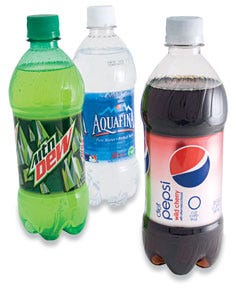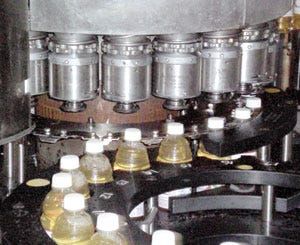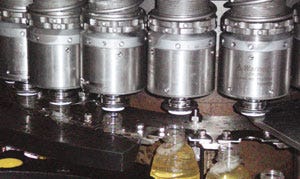The advantages of new magnetic cappers
|
Maintenance, even when it is scheduled, still has the potential to be a disruptive process. The Pepsi Bottling Group (PBG) has taken steps to reduce this potential for disruption. A great example is the work in PBG's Detroit facility, which was rebuilding the magnetic-capping headsets on its cappers approximately every three months. The Detroit plant has two bottling lines, as well as one can line, running many different Pepsi products. “It would take three people eight hours to rebuild the 16 capping heads on Line 1,” says Dwayne Johnson, production technician.
In February 2006, PBG switched the original capping heads on Line 1, which runs 300 to 700 bottles/min, and on Line 2, which runs 1,000 bottles/min on a 20-head capper, from the headsets originally supplied to magnetic-capping headsets from Warner Electric (www.cappingclutch.com).
|
One of the primary advantages of the smooth-torque headsets is that they eliminate cap overtightening. |
|
Bottles enter the capper through a feed screw. |
|
The magnetic-capping headsets utilize a third magnet that eliminates pulsation, resists rotation and provides smooth capping torque. |
PBG has not had to rebuild any of the new headsets since they were installed, but Johnson believes the new headsets will be much easier when they do need to be rebuilt. “Since we have never had to rebuild the Warner heads, it's hard to compare them to those of our previous supplier, but we have torn the Warner heads apart to check for wear and put them back together, and the Warner heads are much easier to work with,” says Johnson.
New technology eliminates pulsation
The standard technology that has been used for years in synchronous headsets is a configuration of two sets of magnetic plates opposing each other, according to Mike Scott, Warner Electric headset product manager. The magnetic plates have multiple magnets.
One magnetic plate is connected to the output shaft, and the other is connected to the input shaft. When the magnet is rotated, it snaps to the next magnetic pole (north and south), so the magnets are snapping over from one pole to the next during the capping operation, which creates a pulsation. To adjust the amount of torque applied by the headset, the operator separates the magnets to lower the peak torque or brings them closer together to increase the torque.
In contrast, the smooth-torque magnetic-capping headsets are designed with three sets of internal magnetic plates. The headsets utilize the same two opposing magnets, north and south, as in the pulsating-torque headsets, but between the two opposing magnets is a third magnet, called a hysteresis magnet, which is connected to the output shaft. With this system, the magnetic energy is flowing into the hysteresis magnet, bringing it to a set energy level that resists rotation, and which provides smooth torque. The output shaft is not pulsating or snapping back and forth from pole to pole. “This is a whole different technology,” says Scott. “We're not changing air gaps. We are changing the angular relationship of the magnetic poles of the driver magnets relative to each other. Our driver magnets do not directly interact with each other, because they have the hysteresis magnet in between them, so we don't have the pulsating torque.”
Eliminating over-tightened caps
One of the primary advantages of Warner Electric's smooth-torque headsets is that they eliminate cap overtightening, which is the top complaint in the capping industry, according to Scott. The headsets reduce the variation in removal torque, which leads to greater efficiency by lowering the standard deviation of removal torque. “The Warner Electric headsets are very consistent,” says Johnson. “After almost two years of running time, we still see the same consistency in application torque that we saw on the day they were installed. Our removal torque holds at +/- one in-lb, which is phenomenal. With our previous heads, we would start losing torque after approximately 10 weeks, which is why we had to rebuild them every three months.”
Says Scott, “The smooth-torque headsets virtually eliminate the overtightening of the caps caused by the pulsation of the synchronous headsets. This is especially important to the plants that are going to the shorter, low-profile cap to save on material costs. As the caps are smaller, there is less for the consumer to grip when removing the cap, so it's becoming more and more important that the cap be easily removed. With these smaller caps, if they are applied really tightly with the pulsating headsets, you're creating a problem, because consumers are not able to remove the cap.” The magnetic-capping headsets also feature visual setting scales for topload force and static torque adjustments that make it easy and quick to accurately set headset topload and static torque.
Maintenance is reduced
Reduced maintenance is a major selling point for Johnson. “With our previous headsets, we had constant maintenance, because of the frequent adjustments and rebuilds. The headsets would become impregnated with water after eight to 10 weeks and would rust through, onto our product. They would also wear out prematurely from the ozone we use to bottle our Aquafina water product. We have not had these problems with the Warner capping heads, and we are going on two years of running time.
The Warner heads are much easier to grease, and the grease does not leak like it did with the other heads. With the other heads, we were greasing once a week; with the Warner heads we reduced greasing to once a month. In general, the maintenance time has been reduced to ¼ of what it was with the other heads, and we have incurred no downtime because of the headsets since installing them almost two years ago.” Overall, Johnson has been very pleased with the entire change to the new magnetic-capping headsets. “Warner has great product support, and its engineering department listened to our ideas and suggestions and was willing to implement or improve upon them. They've always been there when we needed them,” he says.
More information is available: |
Warner Electric, 888/350-1891. www.cappingclutch.com |
About the Author(s)
You May Also Like






